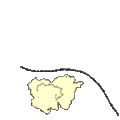Biophysical chemistry facts for kids
Biophysical chemistry is a cool science that helps us understand how living things work at a super tiny level. Imagine being a detective, but instead of solving crimes, you're figuring out the secrets of molecules and structures inside living cells!
This field looks at how different parts of a living system, like a plant or an animal, are built from tiny molecules. It also studies how these molecules work together in bigger groups, called supra-molecular structures, to make life happen.
Biophysical chemists use special tools, often borrowed from physical chemistry, to peek inside these tiny structures. Some of these tools are like super-powerful microscopes that use light or magnetic fields. For example, they use methods like nuclear magnetic resonance (NMR) and X-ray diffraction. These tools help them see the exact shape and arrangement of molecules. A great example of this is how X-ray crystallography was used to study ribosomes, which are tiny factories inside cells that build proteins. This important work even won a Nobel Prize in Chemistry in 2009!
Contents
What Do Biophysical Chemists Study?
Biophysical chemists are curious about many things in living systems. They often focus on two main areas:
Proteins: The Building Blocks of Life
One big area of study is the structure and function of proteins. Proteins are like tiny machines that do almost everything in your body, from helping you digest food to building your muscles.
- Enzymes in Action: A special type of protein is an enzyme. Enzymes are like tiny helpers that speed up chemical reactions. Biophysical chemists study how an enzyme's unique shape allows it to grab onto other molecules, called substrates, and change them. Imagine a lock and key: the enzyme is the lock, and the substrate is the key that fits perfectly into its special "pocket." Sometimes, a tiny metal ion might even help the enzyme work better by changing its shape slightly.
Cell Membranes: The Cell's Protective Skin
Another important area is studying cell membranes. These are the thin, flexible walls that surround every cell, controlling what goes in and out. They are made of special fat-like molecules called phospholipids.
- Understanding Membranes: To understand how real cell membranes work, scientists often create tiny, bubble-like structures called liposomes or vesicles. These are like mini-models of cell membranes. By studying these models, biophysical chemists learn how membranes keep cells safe and allow them to communicate with their surroundings.
Where Did Biophysical Chemistry Begin?
This exciting field has a rich history.
- Max Planck Institute: One of the oldest and most famous places for biophysical chemistry research is the Max Planck Institute for Biophysical Chemistry in Göttingen, Germany.
- DNA Discovery: The Biophysics Department at King's College London in the UK played a huge role in one of the biggest scientific discoveries ever! In the early 1950s, scientists there used X-ray crystallography to study DNA, which is the amazing molecule that carries all our genetic information. Their work was crucial in figuring out DNA's famous double-helix shape.
Related pages
- Biophysical techniques
- Biophysics
Images for kids
-
A ribosome is a biological machine that uses tiny movements to turn RNA into proteins.
See also
 In Spanish: Biofisicoquímica para niños
In Spanish: Biofisicoquímica para niños


